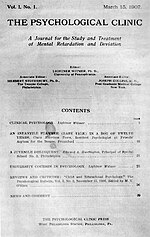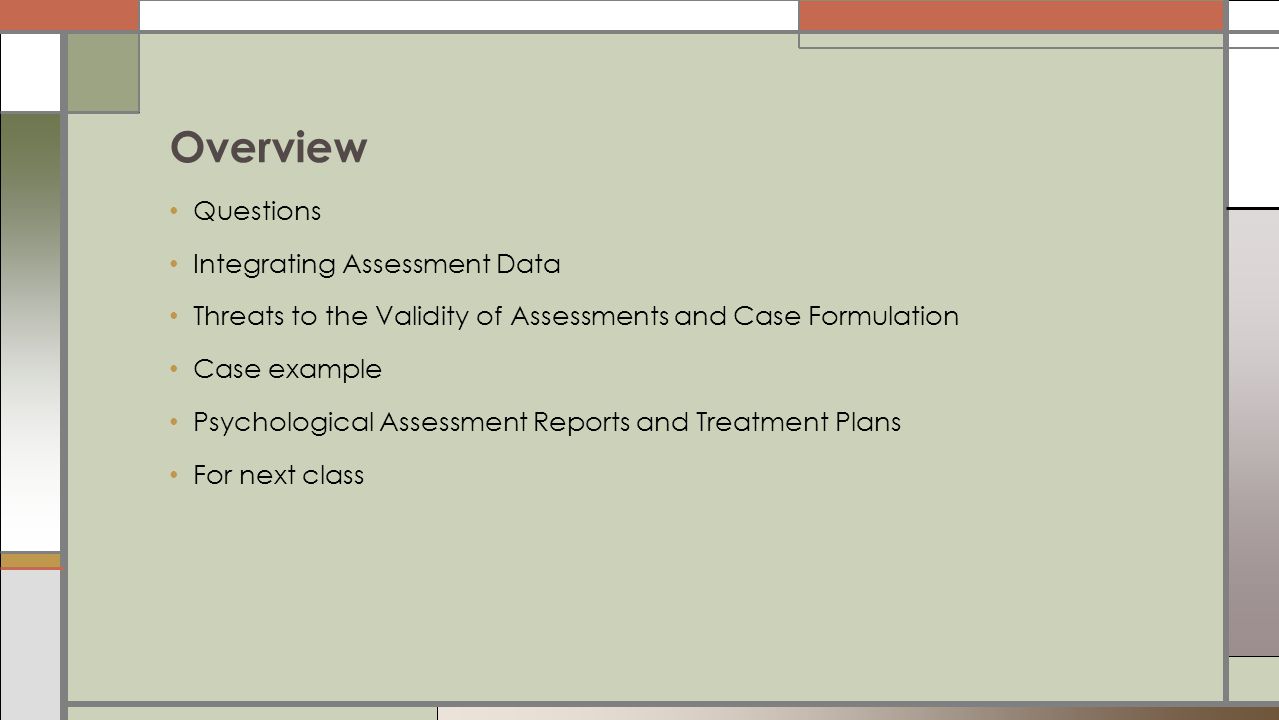- Clinical Psychological Assessment Report Sample Pdf
- Psychology Clinical Assessment Report Example
- Clinical Psychological Assessment Report Sample Form
- Examples Of Psychological Assessment Reports
Psychology Documentation Samples In an effort to continue to enhance Provider knowledge of documentation requirements, MHD has prepared Sample Documentation for review. MHD has no prescribed format for documentation however, the content is required when providing services to ANY MHD participant regardless of Prior Authorization. The Minnesota Report was included during Grace’s initial evaluation in the alcohol and drug treatment center, revealing considerable psychological distress and acting out problems from all three profiles (i.e., Clinical and Supplementary Scales, Content Scales, and PSY-5 Scales). Problems with anger control.
Clinical Psychological Assessment Report Sample Pdf
Jane Smith Dates of Evaluation: 9/12/96
Case No.: 111,111 9/13/96
Building No.: 11
Admission Date: 9/2/96 Date of Report: 9/14/96

PURPOSE FOR EVALUATION: Rather than 'Reason for Referral'the first section for the report is better called 'PURPOSE FOR EVALUATION.' This gives you a lot more flexibility. If you use 'Reason for Referral',you pretty much have to copy whatever the consult says. Unfortunately,many consults ask questions which tests can't answer (or else they don'task any question at all).

Use this section to briefly introduce the patient and the problem. Beginwith a concise 'demographic picture' of the patient. (e.g., This is thethird inpatient admission for this 32 year old, single, white female whohas 13 years of formal education and is employed as a beautician. She wasadmitted due to symptoms of major depression with possible psychotic features.)
Use this section to tell your reader what issues you will address inthe body of the report. In this way, he won't get to the end of your report,then have to think back to decide whether your conclusions were supportedby your data. He'll know on what issues to focus, and he can be forminghis own impressions while he's reading. (e.g., The purpose for the currentevaluation was to screen for evidence of psychosis and clarify the natureof the underlying depressive disorder.) In sum, use this section to 'posea question,' which you will answer in the 'SUMMARY' section.
Finally, if the evaluation takes more than 5 days to complete, you shouldput a progress note in the patient's chart giving preliminary test results.For example, you might conclude the 'PURPOSE FOR EVALUATION' section ofyour report with, 'Preliminary results were reported in the patient'sprogress notes on 9/13/96. The current report will supplement and elaborateupon those preliminary findings.'
ASSESSMENT PROCEDURES: Refer to this section as 'ASSESSMENTPROCEDURES' rather than 'TESTS ADMINISTERED.' This allows you to includethe Mental Status Exam and the Clinical Interview as two of your procedures. This also helps communicate to referral sources that you do more than givesome tests and copy interpretive statements out of a manual. It lets themknow that your evaluation is a professional integration of informationfrom a variety of sources. Be sure to also note who gave the tests andhow long it took. These issues are important if a case ever goes to court.
e.g.: Millon Clinical Multiaxial Inventory-III (MCMI-III)
Minnesota Multiphasic PersonalityInventory-2 (MMPI-2)
Mental Status Examination
Review of Prior PsychologicalAssessment
Review of Prior Medical Records
Clinical Interview
This patient participated in 3 hoursof testing and a 1 hour diagnostic
interview. Tests were administeredby Jim Smith, M.S. and interpreted by
John Jones, M.A..
BACKGROUND INFORMATION: In this section present paragraphsdealing with family, social, legal, medical, family mental health, etc.issues, if needed. Only include those issues that are relevant to the 'questions'posed under 'PURPOSE FOR EVALUATION.' Excessive, unnecessary details willdistract the reader from the case you are trying to build in support ofyour conclusions! Whenever possible, MAINTAINCHRONOLOGICAL ORDER when presenting background information.
Next describe the patient's history of substance abuse/mental problems,and mental health care in CHRONOLOGICAL order. Where possible, provide enoughdetails of prior intervention efforts to clarify what was attempted andwhether it was successful. Your goal is to encourage replication of priorsuccesses and/or avoid duplication of prior treatment failures. Also,be sure to describe the patient's behavior and level of adaptive functioningBETWEEN prior interventions. These details will help give the treatment team an idea of what 'target level' of adaptive functioning to shoot for in the current intervention. Follow with a paragraph describing the onsetand development of the present illness/ exacerbation. Let the reader getan idea of how the current admission compares to prior admissions and whatspecific events precipitated the current admission. End this section witha brief paragraph summarizing staff observations, patient behavior, levelof motivation, etc. during the current admission. Keep in mind that objectiveobservations by professional staff are one of your best sources of data.Conclude with a sentence indicating medications being taken at the timeof testing.
MENTAL STATUS EXAMINATION: Focus on YOUR observations and impressions. This section of the report should focus on your objective evaluation. Avoidquoting the patient's opinion of his own mood, affect, etc. It's also bestto avoid mixing in background information or test information with thissection. A typical MSE for a 'normal' patient might read:
- Results of mental status examination revealed an alert, attentive individualwho showed no evidence of excessive distractibility and tracked conversationwell. The patient was casually dressed and groomed. Orientation was intactfor person, time and place. Eye contact was appropriate. There was no abnormalityof gait, posture or deportment. Speech functions were appropriate for rate,volume, prosody, and fluency, with no evidence of paraphasic errors. Vocabularyand grammar skills were suggestive of intellectual functioning within theaverage range.
The patient's attitude was open and cooperative. His mood was euthymic.Affect was appropriate to verbal content and showed broad range. Memoryfunctions were grossly intact with respect to immediate and remote recallof events and factual information. His thought process was intact, goaloriented, and well organized. Thought content revealed no evidence of delusions,paranoia, or suicidal/homicidal ideation. There was no evidence of perceptualdisorder. His level of personal insight appeared to be good, as evidencedby ability to state his current diagnosis and by ability to identify specificstressors with precipitated the current exacerbation. Social judgment appearedgood, as evidenced by appropriate interactions with staff and other patientson the ward and by cooperative efforts to achieve treatment goals requiredfor discharge.
 RESULTS OF EVALUATION
RESULTS OF EVALUATIONPsychology Clinical Assessment Report Example
: There are several 'models'for writing test reports. For most MSH evaluations the Hypothesis TestingModel is recommended. In this model results are focused on possible answersto the referral question(s). The idea is to present a hypothesis in the'PURPOSE FOR EVALUATION' section, then present data systematically to supportor refute the hypothesis. Separate paragraphs in the 'RESULTS OF EVALUATION'section address theoretical/ conceptual issues by integrating data fromthe history, mental status exam and behavioral observations with data fromall the tests.Specific tests are rarely mentioned by name. For example, informationfrom scale 2 on the MMPI-2 may be combined with interpretive data fromthe MCMI-III dysthymia scale. If the integration of this information isconsistent with the history and the mental status exam, it is includedin a paragraph dealing with depression.
The strength of this model lies in its efficiency and concise focuson the referral problem. The reader isn't distracted by unrelated details. The primary weakness of the model is that you don't report some of theinformation which is unrelated to the 'PURPOSE FOR EVALUATION' but whichcould potentially be useful to other disciplines.
SUMMARY/RECOMMENDATIONS: Begin by specifically answeringthe questions you posed under 'PURPOSE FOR EVALUATION.' Then elaborateas much as needed to present your conceptualization of the case. It's fineto include DSM diagnostic impressions, but your summary of the patient'spsychological makeup is far more important. If you do include DSM labels,be sure you've provided enough detail in the body of the report to supportthe diagnostic criteria as described in DSM. Any recommendations for treatmentcan also go here. For example:
- Results of psychological evaluation reveal an extended history of alcoholabuse and a psychotic disorder characterized primarily by disturbance ofthought content, with relative integrity of thought process and no clearindication of perceptual disturbance. The current clinical presentationappears to represent an acute exacerbation of a chronic psychotic disturbancewhich had its onset approximately 8 years ago. Currently, Mr. Jones appearsto remain extremely distressed, anxious, paranoid, and delusional, despiteself-reports to the contrary. He lacks sufficient capacity/ motivationto rely on external supports and lacks sufficient personal insight to copeindependently at present. The patient appears to be attempting to copewith his illness using extreme guardedness and withdrawal. During recentmonths he has shown no signs of aggressive ideation and is not believedto be a physical risk to himself or others at present.
It is recommended that efforts to establish a trusting relationshipwith this patient be continued, in order to help him cultivate a more adaptivecoping/defensive pattern. Individual therapy will be more productive thangroup interventions. Once his guardedness has been relaxed, it will likelybe beneficial to explore psychosocial issues present at the time Mr. Joneslost his job, as these appear to have partially precipitated the currentpsychotic exacerbation. Additionally, the patient will benefit from encouragementto explore the social and adaptive significance of his substance abusehistory.
Clinical Psychological Assessment Report Sample Form
Please let me know if any additional information is needed concerning theresults of this evaluation. _________________________ ______________________
John R. Jones, M.A. Frank F. Finklemeyer, Ph.D.
Psychology Associate Psychologist II
In an effort to continue to enhance Provider knowledge of documentation requirements, MHD has prepared Sample Documentation for review. MHD has no prescribed format for documentation however, the content is required when providing services to ANY MHD participant regardless of Prior Authorization.
Sample Documents available in PDF format based upon a fictional case are:
- Mock Diagnostic Assessment11/28/2007
- Mock Diagnostic Assessment Update11/28/2007
- Mock Treatment Plan11/28/2007
- Mock Individual Progress Note11/28/2007
- Mock Family Progress Note11/28/2007
- Mock Treatment Plan Update11/28/2007
Examples Of Psychological Assessment Reports
Providers are urged to review the Psychology Manual as well as ongoing Provider Bulletins which continually update providers regarding MHD policy changes.